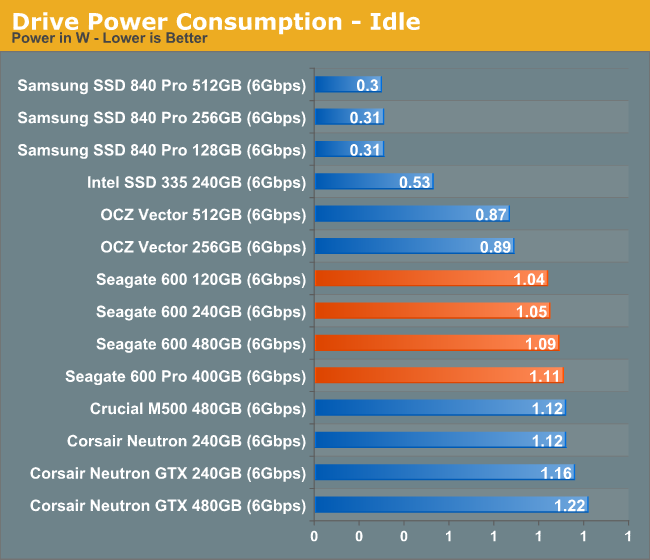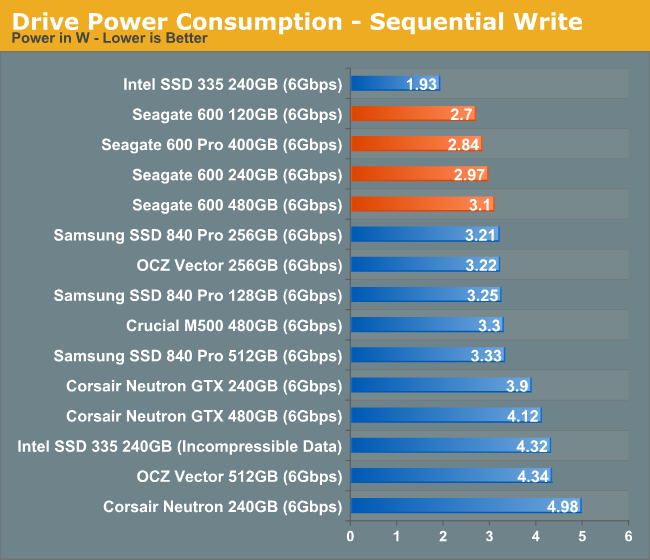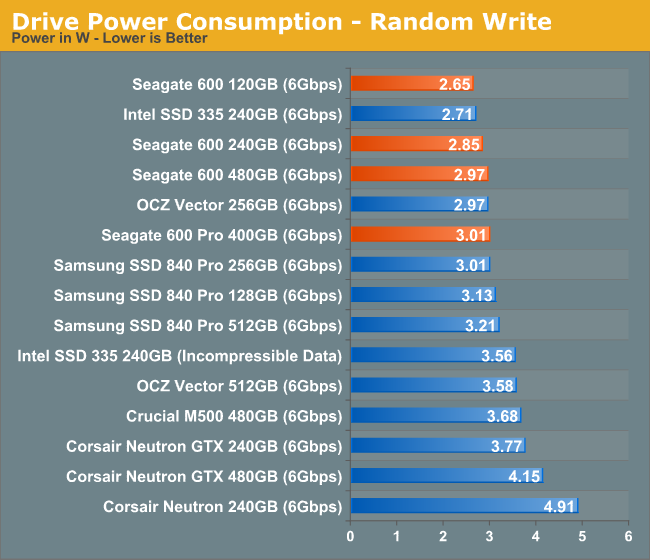The Seagate 600 & 600 Pro SSD Review
by Anand Lal Shimpi on May 7, 2013 8:00 AM ESTPower Consumption
Under load, Seagate's 600 and 600 Pro do a great job on power consumption. The combination of Toshiba's 19nm NAND and whatever firmware tweaks Seagate did result in very compelling power consumption under load. The problem is the 600 is measurably worse than Samsung's SSD 840 Pro at idle. For desktops this shouldn't matter, but notebook users looking to stay on battery as long as possible would be better off with an 840 Pro.













59 Comments
View All Comments
Kristian Vättö - Tuesday, May 7, 2013 - link
The units we have are all based on the older 24nm NAND. A while back I asked Corsair for review samples of the 128/256GB Neutrons (the original ones are 120/240) but they said they are not sampling them (yet). I can ask if they have changed their mind, although there shouldn't be much difference since 19nm Toshiba NAND has the same page/block/die size as 24nm.FunBunny2 - Tuesday, May 7, 2013 - link
Does "Toshiba" mean toggle-mode NAND, by definition? Or do they sell all types?Kristian Vättö - Wednesday, May 8, 2013 - link
Yes, Toshiba uses Toggle-Mode interface for their NAND. Here's the breakdown of NAND interfaces and manufacturers:Toggle-Mode: Toshiba/SanDisk (joint-venture) & Samsung
ONFI: Intel/Micron (aka IMFT, also a joint-venture) & Hynix
LtGoonRush - Tuesday, May 7, 2013 - link
HardOCP showed pretty significant performance increases, though that could also be due to the new firmware (which is not being back-ported as I understand).romrunning - Tuesday, May 7, 2013 - link
I really wish we had more tests of SSDs in RAID-5 arrays. This is really useful for SMBs who may not want/afford a SAN. I'm very curious to see if the 20% spare area affects SSDs just as much when they're RAIDed together as it does standalone. I also don't care of the SSDs are branded as being "enterprise" drives. It would be nice to see how a 5x256GB Samsung 840 Pro RAID-5 array would peform, or even a 5x400GB Seagate 600 Pro RAID-5 array.FunBunny2 - Tuesday, May 7, 2013 - link
No legitimate RDBMS vendor would allow its database on a RAID-5 machine. Never. Never. Never.romrunning - Wednesday, May 8, 2013 - link
I can't tell if you're just trolling or you're actually serious. Obviously, SMBs use RAID-5 arrays ALL the time, and they use "legitimate" database products like MS-SQL, etc. It doesn't have to be an IBM AIX server running DB2, or anything high-end.daniel_mayes - Wednesday, May 8, 2013 - link
What is FunBunny2 talking about? What Raid would you want to run them on 1,5,6,10, no ssd's?You aren't the only one that want's to see more tests with SSD's in a Raid 5. I would also like to see the destroyer run on ssd's with a higher provision and please add Intel DC S3700 to the destroyer benchmark next.
FunBunny2 - Wednesday, May 8, 2013 - link
"I always have found that based on those requirements RAID 5 requires more spindles to satisfy those requirements than RAID 10 - and this has been found even with a Read/Write of 9:1. "here: http://sqlblog.com/blogs/linchi_shea/archive/2007/...
(no, that's not me)
Fact is, SSD still writes slower than reads, so what kind of RAID one uses matters. Having a 3NF (or higher) schema is a more productive avenue for performance on SSD, anyways, irregardless. Getting rid of all that bloated [un|de]normalized byte pile will allow, in most cases, you to have a much smaller database, and thus not worry about bunches and bunches of discs.
romrunning - Friday, May 10, 2013 - link
That blog is from 2007, and SSDs weren't really in the picture at all. It has been demonstrated how SSDs can trump spinning disks in virtually all I/O-bound operations. The man in the blog even showed a test of RAID-5 beating RAID-10 on the same hardware, so his test was in direct contradiction to the one who later commented about spindles.That being said, I think you're trying to say that getting rid of unnecessary in your database will result in a smaller database & thus lower performance requirements. That might be true at one point, but when you've normalized your data already, then additional data will just make the database grow. After all, if you're writing something like electronic orders to your normalized database, it will grow based upon real data addition. That's why you need to make sure your storage array can handle the increased load.
RAID-5 has been the best for SMBs because it provide the fault-tolerance and the higher utilization of total storage capacity that they want. That's why I would like to see tests of SSDs in RAID-5 arrays - to get Anandtech to test these great SSD performers in something I could use in a database server. Something like their tests of their own website databases would be nice, or even smaller ones using a 10-20GB database.